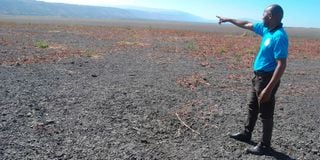Premium
Dried-up Lake Olbolosat leaves a trail of destroyed livelihoods

A man points to what used to be the shores of Lake Olbolosat from the middle of the water body, that is now dry, late last month.
We used to swim and hunt for wild duck eggs in this lake,” a nostalgic Francis Njoroge tells me as he joins us at ground zero, East of Lake Olbolosat.
This is the driest part of Lake Olbolosat. The crusty earth crumbles to the touch, breaking into layers of sediments lined up over the years as the waters from the exposed escarpment descended into the lake when it rained.
It is past 10am and temperatures are well above 25 degrees Celsius. The country is in the throes of a ravaging drought and Lake Olbolosat is its latest casualty.
Mr Njoroge says the decline of Lake Olbolosat has been gradual and he has witnessed it first hand in the 30 years he has lived in Makereka, one of the villages overlooking the lake on the escarpment.
Local tourism
“It started with the springs on the escarpment drying up. We used to depend the springs for water for domestic use. Here at the lake’s shores it was always cold but now it is so hot,” he adds
As a young father, Mr Njoroge is at a loss on what he could tell his child about the lake that was once here.
“I am worried, I know I might sound and look crazy when I tell my child that I once used to fish and swim here and now it is an open grazing ground ,” he says.
The drying of Lake Olbolosat has had an immediate impact on local tourism . Hotels and lodges have shut down and the boats that once took tourists on rides have been grounded.
“Our economy has been gravely affected. Fisherfolk and hotel workers have lost their livelihoods and this has led to a rise in crime,” says Mr Amos Wainanina, an official at the Lake Olbolosat Conservation Group.
The arrival of the pastoralists from Laikipia and Samburu counties here means Ewaso Ng’iro River, which has its source at the lake, has dried up and communities downstream have to move up to seek water and pasture. Even though there is little animosity towards the visiting herders at the moment, fears are rife that, should the drought persist, conflict will be inevitable.
“If the grass is depleted and the rains fail, these herders will take their livestock towards the farms in Kinangop and that can only mean war,” Mr Wainaina says.
Tensions between the host community and herders is palpable with locals saying they cannot allow their livestock to mingle with those from Samburu and Laikipia due to fear of conflict.
We tried to speak with the herders but were met with curt replies that they did not own the flocks that were being driven into the lake. The locals have also devised a way to benefit from the grass,which they package and sell it to the pastoralists.
Nduthi Springs, which drains into Lake Olbolosat, is chocked with pipes that people are using to draw the water into their farms for irrigation.
From Nyandarua, we went to Thomson Falls in Laikipia County where the waters of Lake Olbolosat resurface through River Manguo. The falls are a favourite destination for local tourists who comprise 95 per cent of the visitors. It is evident that the volume of the falls has declined and Ms Caroline Kathambi, the county’s Tourism Chief Officer, says thousands of lives would be affected should the falls dry up.
Human activity
“The falls have created job opportunities for hotels workers, photographers and curio shop owners,” she adds.
Most of the springs and rivers in Lake Olbolosat’s ecosystem are sourced in the Aberdare Ranges, a 100-kilometre long range of mountains traversing Nyeri, Laikipia and Nyandarua counties.
When we visited the Aberdare National Park, it was just after a two week inferno razed more than 40,000 acres. The fire was attributed to human activity and the prevailing dry weather.
According to Kenya Wildlife Service (KWS) Mountain Region Assistant Director Mungumi Bakari, the drying up of Lake Olbolosat was only a matter of when, not if, having first documented the deteriorating ecosystem when he was Park Warden at the Aberdare National Park a decade ago.
“I am not surprised that the lake is drying up,” he says.
Water Resources Authority (WRA) Ewaso Ng’iro North Basin Coordinator John Munyau says they have stopped all irrigation from the Ewaso Ngiro River after the water levels hit a record low.
“Reserve flow has been affected by the drought. We have had four years of the river not being replenished. Springs have not been recharged over that period the situation is at an alarm stage,” he says. However, WRA is overwhelmed by the illegal connections responsible for the lack of flow in waterways in the Lake Olbolosat ecosystem.
“Most of the people abstracting water are not licensed and are compromising the flows in our rivers,” Mr Munyua adds.
For Prof Simon Onywere, an associate professor of Environmental Planning and Management at Kenyatta University, human activities are to blame for the degradation of Lake Olbolosat and this could trigger for future conflict as those living downstream move towards the source of the river.
“We know from our laws that steep escarpments should not be occupied and should be protected. That policy has been ignored and people are settling on the escarpments,” says Prof Onywere.
While this is not the first time that Lake Olbolosat has dried up, the presence of pastoralists on the lake has never been recorded and the Cabinet Secretary for Interior and Coordination of National Government, Prof Kithure Kindiki, has alluded to the development as being a national security concern.
“When a resource like this disappears, the kind of instability it brings because of conflict between communities and the changed livelihoods is quite significant,” he said while on a tour of Nyandarua in February.
The United Nations Environment Programme cites climate change as a big threat to peace and security in its 2020 report on Gender, Climate and Security.
The Nyandarua County Government has no control over what is happening at Lake Olbolosat, says Environment Executive Samuel Wachira.
He, however, adds that the process of gazetting the wetland have kicked off with the intention of incorporating the KWS in the management of the resource.
“We are escalating the registration so that the county is in charge of the lake while KWS protects the wild animals. But in order to safeguard against continued encroachment, someone needs to be in charge,” he says
Environmental experts say that, for Lake Olbolosat to recover, drastic actions must be taken.
“Of immediate concern is to put in place policies to make sure no one is allowed to remain in the riparian area,” says Prof Onywere.
What has happened to Lake Olobolosat is a classic case of neglect and blame shifting and as the meteorological department predicts below-average rainfall in the March-April- May long-rains season that is currently underway. This could mean the beginning of the end for Ewaso Ng’iro River and the millions of lives it supports in northern Kenya.





